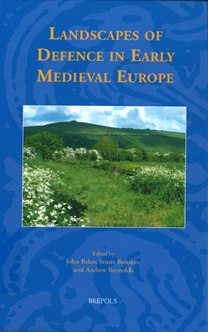
Publications
Members of the INS have published on many areas of place-names and more widely on the cultures, literatures, and languages of the early medieval period.
Publications have also resulted from collaborations with external institutions and multidisciplinary research projects. Please see our research projects pages for more information.
Selected recent publications
- J. Baker, ‘Brittonic influence on the place-names of Stottesdon hundred, Shropshire’, in S. Bassett and A. J. Spedding (eds), Names, Texts and Landscapes in the Middle Ages: A Memorial Volume for Duncan Probert (Donington: Shaun Tyas, 2022), 112–22.
- P. Cavill with S. Beach, The Place-Names of Shropshire, Part Seven: Stottesdon Hundred and the Borough of Bridgnorth, (Nottingham: EPNS, 2020).
- J. Baker and J. Carroll, with S. Beach, The Place-Names of Shropshire, Part Eight: Overs Hundred, the Borough of Ludlow, the southern part of Munslow Hundred, and the Stowe Division of Purslow Hundred, (Nottingham: EPNS, 2020).
- J. Carroll and S. Kilby, '‘'Preparing the Ground: Finding Minor Landscape Names in Medieval Documents', The Local Historian, 49.4, (October 2019).
- Jayne Carroll, A. Reynolds, and B. Yorke (eds.), Power and Place in Europe in the Early Middle Ages, (London: British Academy, 2019).
- J. Baker with S. Beach, The Place-Names of Shropshire, Part Seven: Stottesdon Hundred and the Borough of Bridgnorth, (Nottingham: EPNS, 2018).
Recent postgraduate publications
- Abigail Lloyd, ‘Stonyborow: a clue to a Roman settlement in rural Oxfordshire? The symbiotic relationship between field-names and archaeological data’, Journal of the English Place-Name Society, (forthcoming).
- Jessica Treacher, 'Review of Redmonds, G. (2017) A Vocabulary of Wood, Wood-Workers and Wood Management in Yorkshire', in Journal of the English Place‑Name Society, (50: 2018), pp.116-18.
- Jessica Treacher, 'Review of Williamson, T., G. Barnes and T. Pillatt (2017) Trees in England: Management and disease since 1600', in Journal of the English Place‑Name Society, (49: 2017), pp.154-5.
- Joshua Neal, Eleanor Rye and Jessica Treacher, 'Bibliography 2016', in Journal of the English Place‑Name Society, (49: 2017), pp.171-6.
Selected further publications
Jayne Carroll, Stephen Harrison and Gareth Williams (eds), The Vikings in Britain and Ireland (British Museum, 2013)
For nearly three hundred years, from the end of the eighth century AD until around 1100, the Vikings set out from Scandinavia across the northern world – a dramatic time that would change Europe forever. Exploring the Viking conquest and settlement across Britain and Ireland, this lively history book looks at the impact of Viking forces – the development of towns and societies, their trades and beliefs, language and their interactions with native peoples. Drawing on the superb collection of the British Museum, together with other finds, sites and monuments, this book celebrates the vibrant diversity of Viking culture, and provides an intriguing insight into their daily life and their legacy, which is clearly signposted around Britain and Ireland today.
John Baker and Stuart Brookes, Beyond the Burghal Hidage: Anglo-Saxon Civil Defence in the Viking Age (Brill, 2013)
As the title suggests, Beyond the Burghal Hidage takes the study of Anglo-Saxon civil defence away from traditional historical and archaeological fields, and uses a groundbreaking interdisciplinary approach to examine warfare and public responses to organised violence through their impact on the landscape. By bringing together the evidence from a wide range of archaeological, onomastic and historical sources, the authors are able to reconstruct complex strategic and military landscapes, and to show how important detailed knowledge of early medieval infrastructure and communications is to our understanding of Anglo-Saxon preparedness for war, and to the situating of major defensive works within their wider strategic context. The result is a significant and far-reaching re-evaluation of the evolution of late Anglo-Saxon defensive arrangements.
This book arose from the Beyond the Burghal Hidage research project.
John Baker, Stuart Brookes and Andrew Reynolds (eds), Landscapes of Defence in Early Medieval Europe (Brepols, 2013)
This volume is a result of a conference at University College London in 2007 which addressed the scale and form of civil defences in early medieval Europe, c. 800-1000. Previous work has largely focused on individual sites or specific categories of evidence. These papers offer new interdisciplinary perspective driven by a landscape approach. Several contributions focus on civil defence in England around the time of King Alfred the Great, and together provide a new agenda for the study of Anglo-Saxon military landscapes. European case-studies facilitate a comparative approach to local and regional defensive structures and interpretive paradigms. Topics and themes covered include civil defence landscapes, the organization and form of defensive structures, and the relationships and dynamics between social complexity, militarization, and external threats. With papers ranging from England to Spain and Germany to Scandinavia the volume is of relevance to a range of disciplines including archaeology, history, onomastics, geography, and anthropology.
This book arose from the Beyond the Burghal Hidage research project.

Jayne Carroll and David N. Parsons (eds), Perceptions of Place (English Place-Name Society, 2012)
This volume takes stock of the progress of English place-name study over the last hundred years: approaches and methods, changing currents of opinion, recent conclusions, and further possibilities. Drawing on the documentation and analysis provided by the 89 volumes to date of the Survey of English Place-Names – as well as a century of related work – scholars from a range of disciplines reflect on the languages and cultures that shaped early England, on English place-names in neighbouring territories, and on the interface between name-study and related approaches to understanding the history, cultures, landscapes and languages of the past.
You can view more publications by specific INS members by visiting our People page.The EPNS distributes various place-name related works. For ordering and general enquiries,
please visit their website.
Back to top